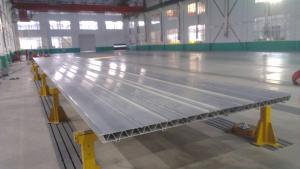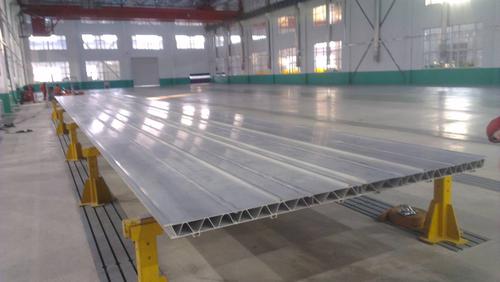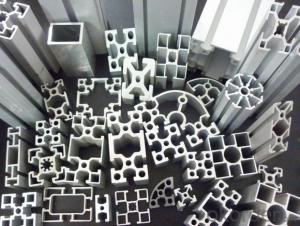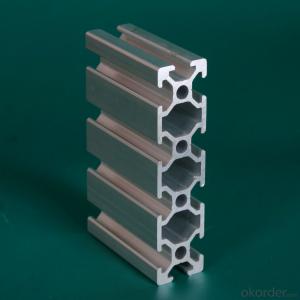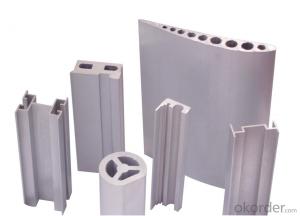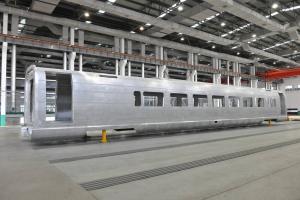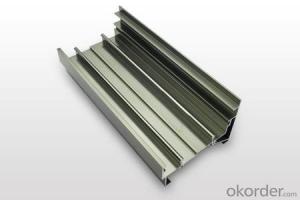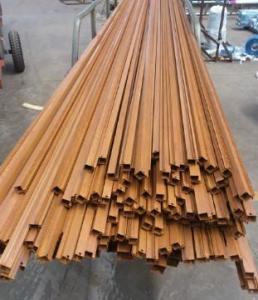Aluminum Profiles Extrusion for Ship Deck
- Loading Port:
- China Main Port
- Payment Terms:
- TT OR LC
- Min Order Qty:
- -
- Supply Capability:
- -
OKorder Service Pledge
OKorder Financial Service
You Might Also Like
Aluminium profile for ship deck
1. Surface: Mill surface treatment
2. Alloy:5083 alloy temper.
3. Size:various dimensions to meet customer’s requirement
4. Advantage:
This ship desk is made with 5083 aluminum profile which has ultra high strength and security, anti-Rust and anti-corrosion. The main advantage with such alloy is as following:
Recycling: this aluminum alloy is easy to be recycled.
Durability and long service life: this aluminum material can be used for 30 years.
Impact resistance: impact resistance of aluminium alloy is higher than steel material.
Quick repairability,: Aluminium can be quickly repaired after colliding
Light weight so to improve ship speed.
Personalization: we can make customized boats according to the customer's requirements and designs.
5. Package:
Standard packaging: 10 pcs of profiles wrapped tightly in one bundle with at least 3 layers of heat-shrinkage at two ends and middles of the bundle, card strips will be used to separate different layers.
6. Life time: Last for 50 years
7. Standard: EN755-9 standard
- Q: This question asks about the effects of utilizing aluminum profiles in the construction industry on the environment.
- <p>The environmental impacts of using aluminum profiles in construction are multifaceted. On the positive side, aluminum is lightweight and strong, reducing the amount of material needed and potentially decreasing energy consumption in transportation. It is also recyclable, which can reduce waste and the need for raw material extraction. However, the production of aluminum requires significant energy, often from non-renewable sources, contributing to carbon emissions. Additionally, while recycling reduces environmental impact, it still consumes energy and can generate waste. The longevity and durability of aluminum can lead to less frequent replacement, reducing construction waste, but improper disposal can lead to pollution. Overall, the environmental impact depends on the balance between these factors and the specific practices of aluminum production and use in construction.</p>
- Q: Household aluminum profiles, which brand of cost-effective? Recommend!
- Cost performance is better, in our Nanshan factory is called a good fight,
- Q: Are aluminum profiles suitable for partition walls?
- Yes, aluminum profiles are suitable for partition walls. They are lightweight, durable, and offer excellent structural support. Additionally, aluminum profiles are easy to install, maintain, and can be customized to fit different design requirements. They also provide good thermal and sound insulation properties, making them a popular choice for partition walls in various settings such as offices, homes, and commercial spaces.
- Q: This question asks for an explanation of various methods used to manufacture aluminum profiles, which are long, extruded shapes made from aluminum.
- <p>Aluminum profiles are manufactured using several processes, primarily extrusion, but also including casting, rolling, and machining. Extrusion is the most common method, where aluminum is heated and forced through a die to create a desired shape. Casting involves pouring molten aluminum into molds to form specific profiles. Rolling is used to produce flat sheets or plates, which can then be further processed. Machining involves cutting and shaping aluminum using tools like lathes and mills. Other processes include forging, which deforms aluminum under high pressure, and powder metallurgy, where aluminum powder is compacted and sintered into a solid profile. Each process has its advantages and is chosen based on the desired profile shape, strength, and application.</p>
- Q: How do aluminum profiles compare to other materials like steel or wood?
- When comparing aluminum profiles to materials such as steel or wood, there are several advantages to consider. Firstly, aluminum is a lightweight material, making it easier to handle and transport. This characteristic also results in reduced installation time and cost. On the other hand, steel is considerably heavier, posing a greater challenge when working with it. Secondly, aluminum profiles possess excellent corrosion resistance. Unlike steel, which can rust over time, aluminum naturally forms a protective oxide layer that prevents corrosion. This feature makes aluminum profiles more suitable for outdoor applications or environments with high humidity or exposure to harsh chemicals. Additionally, aluminum is highly malleable, allowing for effortless customization and fabrication. It can be easily extruded into various shapes and sizes, making it versatile for different architectural and industrial applications. Conversely, wood is limited in terms of its shape and size due to its natural properties. Furthermore, aluminum offers good thermal conductivity, meaning it can efficiently transfer heat. This makes it an ideal choice for applications that require heat dissipation, such as heat sinks or radiators. In contrast, steel has lower thermal conductivity. In terms of aesthetics, aluminum profiles provide a sleek and modern look, which is often desired in contemporary designs. Wood, although providing a natural and warm appearance, requires regular maintenance and can deteriorate over time. Lastly, aluminum is a sustainable material. It is 100% recyclable and can be reused without losing its original properties. While steel is also recyclable, wood is not as easily recycled and can contribute to deforestation. Overall, aluminum profiles offer numerous advantages over materials like steel or wood, including lightweight construction, corrosion resistance, malleability, thermal conductivity, aesthetic appeal, and sustainability. These factors make aluminum a popular choice in various industries, including construction, automotive, aerospace, and electronics.
- Q: This question asks for a list of various fastening methods used to connect aluminum profiles to the structural frames of buildings.
- <p>There are several types of fasteners used to attach aluminum profiles to building frames, including: 1) Bolts and Nuts: Commonly used for strong, secure connections. 2) Rivets: Provide a permanent connection that is resistant to vibration. 3) Self-Tapping Screws: Can be used in materials without pre-drilling. 4) Structural Glue: Offers a strong bond and is often used in combination with mechanical fasteners. 5) Welding: Used for permanent, load-bearing connections, though not common for aluminum due to the risk of thermal distortion. 6) Clamps and Brackets: Used for temporary or adjustable connections. 7) Adhesive Tapes: Provide a quick and easy method of attachment, though not as strong as other methods. Each type of fastener has its own advantages and is chosen based on the specific requirements of the construction project.</p>
- Q: What are the different packaging options available for aluminum profiles?
- Aluminum profiles can be packaged in various ways to meet the specific needs and preferences of manufacturers or customers. The available packaging options include bundling, boxing, tubing, palletizing, and customized solutions. For larger profiles or bulk shipments, bundling is commonly used. This involves stacking multiple profiles together and securing them with strapping or shrink wrap. Smaller profiles can be packaged in boxes, which provide protection during transportation and storage. Individual compartments within the box prevent damage from rubbing. Circular profiles can be packaged in tubes made of durable materials like cardboard or plastic. These tubes offer excellent protection from scratches or dents. When shipping in large quantities, pallets can be used. Profiles are stacked on a pallet and secured with stretch wrap or straps. This option enables easy handling and transportation using forklifts or pallet jacks. In certain cases, customized packaging may be necessary. This can include foam inserts, protective film, or other specialized materials to ensure maximum protection during transit. When selecting the appropriate packaging option for aluminum profiles, it is important to consider factors such as size, weight, fragility, and transportation requirements. Compliance with industry standards and regulations should also be taken into account to ensure safe delivery to end-users.
- Q: This question asks for a method to determine the quantity of aluminum profiles needed for a construction project.
- <p>To calculate the amount of aluminum profiles required for a building project, follow these steps: 1. Determine the project's design and specifications to identify where aluminum profiles are needed. 2. Measure the dimensions of the areas requiring aluminum profiles (length, width, height). 3. Calculate the total linear footage needed by multiplying the dimensions. 4. Consider the profile's cross-sectional area and the project's load-bearing requirements. 5. Account for waste and additional material for joints, connections, and potential errors. 6. Consult with suppliers or use industry-standard formulas to determine the exact quantity of profiles needed. 7. Review and adjust calculations as the project progresses to ensure accuracy.</p>
- Q: Can aluminum profiles be used for signage?
- Signage can indeed utilize aluminum profiles. Aluminum, a material known for its versatility and durability, is commonly utilized in various signage applications. It boasts numerous advantages, including its lightweight nature, resistance to corrosion, and ease of manipulation. Aluminum profiles can be effortlessly shaped into diverse forms and sizes, rendering them suitable for a vast array of signage needs. Furthermore, these profiles can be powder coated or painted to attain the desired color and finish, thereby enhancing the signage's overall appearance. Notably, aluminum is an environmentally friendly option for signage projects as it is highly recyclable, contributing to its sustainability. All in all, due to their durability, versatility, and aesthetic appeal, aluminum profiles remain a favored choice for signage projects.
- Q: What are the different surface embossing options for aluminum profiles?
- Some of the different surface embossing options for aluminum profiles include brushed, mirrored, textured, patterned, and perforated finishes.
Send your message to us
Aluminum Profiles Extrusion for Ship Deck
- Loading Port:
- China Main Port
- Payment Terms:
- TT OR LC
- Min Order Qty:
- -
- Supply Capability:
- -
OKorder Service Pledge
OKorder Financial Service
Similar products
Hot products
Hot Searches
Related keywords
